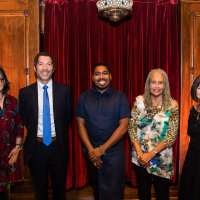“An artist with an instrument is every bit as ‘shovel-ready’ as a potential new highway. In fact, without some help maintaining jobs in culture in, say, struggling downtown Cleveland, there is one fewer reason to build another way to get there.”
So says Chris Jones, theater critic for the Chicago Tribune, in his Feb. 9 blog post.
As we follow the maddening, sausage-making process that will eventually lead to the signing of a stimulus bill, the arts world is being battered by both its champions (the number of e-mail petitions that have hit my computer is a record), and its tone-deaf critics, who disregard the human, economic, and diplomatic value of the arts so acknowledged and supported by the administrations of John Adams, Franklin Roosevelt, and John Kennedy.
In his Los Angeles Times blog, Christopher Knight lists five reasons why Congress hates the arts, including the idea that as nonprofits, the arts offer no opportunity for lobbyists, and that the arts deal with sex.
What is it about art and culture that gets Americans so angry? Where did the negative fantasy of an artist come from? You know the one – a sloppy, semi-crazy guy who never wears a suit, sitting in self-indulgent splendor in his messy studio, answering to no one but his own desires and thumbing his nose at society with paintings intentionally designed to offend. How many artists do that? And is that fantasy image maddening to Americans because so many of us have so little satisfaction in our “keeping up with the Joneses” society?
The artists I know are among the hardest working people in any profession. They have invested years of education and skill-building in their craft – be it playing an instrument, understanding the chemistry of glazes and metals, torturing the body to perfect the techniques of modern dance or ballet, etc. And more years of cobbling together a living from part-time teaching or waitressing, or serving as Starbucks “barristas,” bike messengers, and secretaries so they can, more often than not, volunteer in community theater productions or get a short-term residency teaching art in a community center to build a resume and make contacts for an always-uncertain future. These folks don’t walk out of college into $75,000-a-year jobs.
Why should we be angry at the artist with no health insurance or pension whose work finds an audience willing to pay a few thousand dollars, and yet applaud (note the artistic term) the performance (another artistic term) of the bank executive or corporate CEO who makes millions on shady insider deals? Who is more self serving? Why are men in suits valued more than people willing to get their hands dirty, work up a sweat, and perfect a craft that is equal parts intellectual rigor, pursuit of physical perfection, and an effort at elevating the human spirit?
Well, we know the answers. How many generations of us have had no contact with the arts? How many have had their creative natures deadened by rote learning and their human values subverted by a society steeped in predatory capitalism? Has anybody in Congress noticed that it is the nations whose people celebrate their culture and value it for their children that are the ones leading the world economy? And that the nation that has denied the value and eliminated the arts from its educational system is the one that has brought the world’s economy to its knees?
With the arts being stripped from the recovery bill – both for the NEA and for very practical educational benefits and economic stimulus projects – we can expect there to be little “recovery” for American creativity in future generations.

